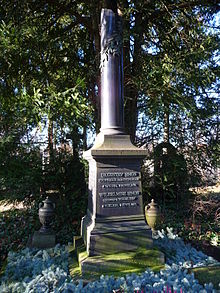Gustav Simon (medic, 1824)

Gustav Simon (born May 30, 1824 in Darmstadt ; † August 21, 1876 in Heidelberg ) was a German surgeon and university professor in Rostock and Heidelberg.
Life
Simon studied at the Hessian Ludwig University in Gießen and the Ruprecht Karls University in Heidelberg . He became a member of the Corps Starkenburgia (1843) and the Corps Saxo-Borussia Heidelberg (1845). In 1848 he was promoted to Dr. med. PhD. He was then a military doctor in Darmstadt until 1861. At the request of Carl Friedrich Strempel , in 1861 he received an associate professor for medicine at the University of Rostock . In the same year he came to the Rostock chair for surgery and ophthalmology. During the German War he headed the club reserve hospital in the barracks of the 2nd Guard Uhlan Regiment in Berlin. In 1868 he moved to Heidelberg as full professor and director of the surgical clinic. Simon particularly promoted war surgery, plastic surgery and gynecology . In 1869 he achieved the first nephrectomy .
Simon first made a name for himself in the treatment of cervical vaginal fistulas, a common complication of the imperfect obstetrical methods of the time. He learned the necessary techniques from Jobert de Lamballe in Paris, who had developed a successful surgical method for this for the first time. With some friends from Darmstadt, Simon founded a private hospital that introduced these methods in Germany. Because of his reputation he became a professor in Rostock. Simon was a persistent and adventurous surgeon who was completely dedicated to his profession. To investigate a particular case, he once wandered the country for hours with a sprained ankle, which later forced him to move on crutches for years. In 1868 he took on the case of the patient Margaretha Kleb, from whom the removal of an ovarian tumor had led to the destruction of a ureter and the formation of a fistula through which the urine was emptied from the abdominal cavity. After several unsuccessful operations, he saw no choice but to remove a kidney, which had never been done before. Simon experimented on dogs before venturing into the operation, which was successfully performed on August 2, 1869, in front of a fellow auditorium.
In 1872 Simon was one of the founding members of the German Society for Surgery (DGCH). In the history of the association he was the "real intellectual originator of the society". After taking over the professorship in Rostock, he began to bring the doctors from the Universities of Kiel, Greifswald and Rostock together to form a so-called Baltic Association . This gave rise to the idea of a German surgeons' association, for which Simon was able to win over his colleagues Bernhard von Langenbeck and Richard von Volkmann in 1871 . In March 1872 the three surgeons started their founding initiative with a circular.
The Südwestdeutsche Gesellschaft für Urologie honors outstanding personalities who have advanced urology in Germany with the Gustav Simon Medal.
Honors
- Privy Councilor
- House Order of the Wendish Crown , Knight
- Grand Ducal Hessian Order of Merit III. Kl.
- Royal Crown Order (Prussia) III. Kl.
Works
- Gustav Simon (Grand Ducal Hessian military doctor): About gunshot wounds . combined with a report on the in Grossh. Military Lazareth in Darmstadt treated the wounded from the summer of 1849. Ernst Heinemann, Heyer's University Bookstore, Giessen 1851, OCLC 916967625 ( limited preview in the Google book search).
- Gustav Simon: About the healing of the bladder vaginal fistula . Assessment of the Opération autoplastique par glissement by Jobert (de Lamballe) in Paris: new method of suturing, the double suture, to unite the edges of the fistula. Ernst Heinemann, Giessen 1854, OCLC 65908450 ( online in the Internet archive ).
- Gustav Simon: The extirpation of the spleen in humans according to the current standpoint of science . Ernst Heinemann, Giessen 1857, OCLC 46211630 ( online in the Internet Archive ).
- About the operation of the bladder vaginal fistula , Rostock 1862.
- Messages from the Rostock Surgical Clinic , Prague 1868.
- Surgery of the kidneys , 2 volumes, Stuttgart 1871–1876.
literature
- Julius Pagel : Simon, Gustav . In: Allgemeine Deutsche Biographie (ADB). Volume 34, Duncker & Humblot, Leipzig 1892, pp. 369-371.
- Dagmar Drüll: Heidelberger Gelehrtenlexikon 1803-1932 . (Ed.): Rectorate of the Ruprecht-Karls-Universität-Heidelberg. Springer Berlin Heidelberg Tokyo. 2012. 324 pp. ISBN 978-3642707612
Web links
Individual evidence
- ↑ Kösener Corpslisten 1930, 38/137; 71/284
- ↑ Dissertation: Examination of the air content in the lungs using the spirometer .
- ↑ Their path of suffering is described in Jürgen Thorwald The Century of Surgeons .
- ↑ Jutta Maier: On the history of kidney transplantation , dissertation Ruprecht-Karls-Universität Heidelberg , academic supervisors Wolfgang U. Eckart and Sigmund Pomer, 1998, p. 6.
- ↑ Gustav Simon Medal of the Southwest German Society for Urology eV online ( Memento from February 14, 2016 in the Internet Archive )
| personal data | |
|---|---|
| SURNAME | Simon, Gustav |
| BRIEF DESCRIPTION | German surgeon and university professor |
| DATE OF BIRTH | May 30, 1824 |
| PLACE OF BIRTH | Darmstadt |
| DATE OF DEATH | August 21, 1876 |
| Place of death | Heidelberg |

